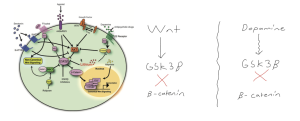Bipolar disorder, major depression, and schizophrenia are psychiatric conditions that make daily life difficult for many in society. Whether it’s the person who suffers from the disease, their family and friends, or even their caretaker, schizophrenia can be especially difficult to handle. Characterised broadly as a condition where someone’s reality is viewed abnormally, those with schizophrenia can experience disorderly thinking that can lead all the way to having hallucinations and delusions. This can impair their daily life often leading to the need for full time care and oversight. Current schizophrenia treatments include the use of antipsychotic medications which often have multiple side effects to the patient, ultimately leading to a low patient compliance. Beyond the lack of current treatment, the factors that contribute to the diagnosis are still under scrutiny. At a basic level, schizophrenia can see its rise from interruption of proper neural development in adolescence. A review by Michaud and Pourquie dove into the molecular pathways that have shown potential contributing factors to this developmental dysfunction.
Two Important Molecules
Michaud and Pourquie devoted their attention to a molecular pathway that involves two molecules, Wnt and GSK3β. Wnt is a molecule that binds outside of the cell and is responsible for maintaining the activation of GSK3β inside of the cell. GSKβ, when it is activated by Wnt receptors, will inhibit the action of another molecule called β-Catenin. β-Catenin is responsible for the transcription of genes in the cell nucleus that are pivotal for proper neurological development. Thus, schizophrenia at its simplest form may be linked to the inhibition of β-Catenin by Wnt and GSK3β signalling.

Above is Figure 2 from the review placed next to a simplified depiction of the two factors that affect β-Catenin and subsequent development of schizophrenia.
Multiple different factors are being studied that affect Wnt-GSK3β signalling. One of the biggest molecules that contributes to this is dopamine. When there is a high amount of dopamine signalling, a cell will allow GSK3β to remain in its active state. When this occurs, β-Catenin will remain inhibited. This will lead to dysfunction of cell development.
Genetics
Genetics are also being considered as a factor that contributes to the development of schizophrenia. Research has assessed specific genes that may contribute to the disease along with specific changes to the individual “codes” that make up a DNA message; these are called single nucleotide variants. There are also copy number variants, which are composed of multiple genes. These can contribute to the development of schizophrenia by affecting the proper development of neurons whether it be through its affect to signalling mechanisms or other factors. Animal models are currently being used to assess these genetic factors but more research is needed.
Looking Into The Future
Schizophrenia can appear in adolescence and can occur from both interruptions to normal cellular signalling along with other genetic factors. Seeing that it has a strong relation to neural development, monitoring of the conditions that lead to schizophrenia development may serve valuable. Developing monitoring systems for chemical signalling like Wnt and GSKbeta may help assess abnormality in neural development before it becomes a problem. This can also apply to assessing for genetic variation in an individual through genome sequencing. These two interventions, however, both come with costs and ethical considerations. However, as we build understanding, we may soon have ways of assessing the development of schizophrenia before it becomes too late to fix it.
Jacques L. Michaud and Oliver Pourquie, “An emerging role for Wnt and GSK3 signaling pathways in schizophrenia.” Clinical Genetics 83, 511-517, (2013)